Following three years of extraordinary turbulence in the church, 2023 appears to be a year that will be about as ‘regular’ as anything church leaders have seen in a few years, while also introducing additional elements of the future church that’s being built as we speak.
Of course, normal has changed again. The external crises that have defined the last few years will give way to a more silent crisis and some opportunity: The way people see the church in the West, particularly in America, continues to become more post-Christian.
Because the chaos of the last few years might subside (even a bit), as a church leader, 2023 will give you an opportunity to address the underlying crisis that’s been happening for decades: The decline of the church.
This year’s trends focus on how the decline in church attendance is happening, but more importantly, some things pastors and church leaders can do to help reverse it.Because the chaos of the last few years might subside (even a bit), as a church leader, 2023 will give you an opportunity to address the underlying crisis that’s been happening for decades: The decline of the church.CLICK TO TWEET
Here are 8 church trends to watch in 2023.
1. The Boomer Church Will Decline and (Eventually) Disappear
In 2023, the oldest Boomers turn 77, and the youngest will celebrate their 59th birthdays.
Boomers have been the heart of most churches for decades on end. This is true of mainline and evangelical churches and growing churches and declining churches.
Born between 1946 and 1964, Boomers have been the center of the megachurch movement too. They not only led them, but they’ve served, given, and attended in droves. In 2023, the oldest Boomers turn 77, and the youngest will celebrate their 59th birthdays.
The relative age of the Boomers is starting to impact trends big time.
Since 2020, Boomers have become the least likely demographic to return to church. 22% saying they have stopped attending church entirely. Only 16% of Millennials have stopped attending.
Similarly, while 54% of Millennials attend primarily in person, 65% of Boomers say they only attend in person.
This means that, unlike Millennials, Boomers don’t track with church when they’re not in the building. Millennials and Gen X are quite comfortable with hybrid church, while Boomers, for the most part, haven’t embraced it.
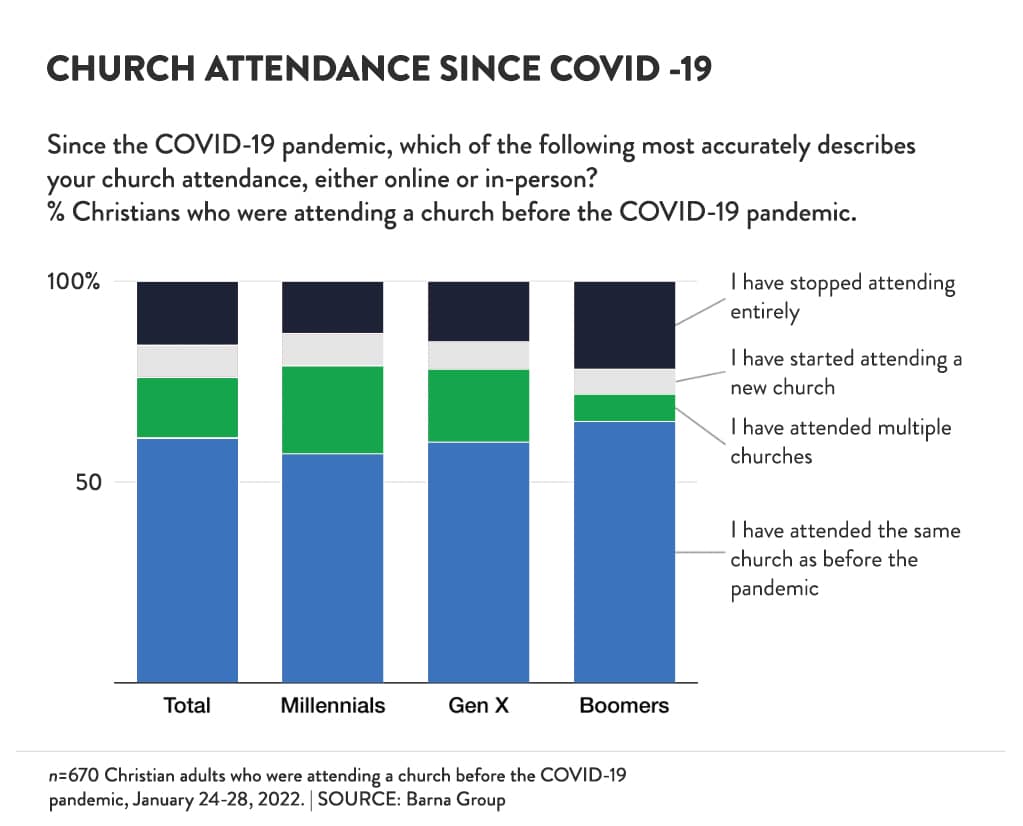
This has profound implications for churches in three primary areas:
- Attendance
- Volunteering
- Giving
First, when it comes to attendance, even as churches return to pre-COVID levels of attendance, Boomers who have dropped out are among those not returning.
The double factors of Boomers not returning and growing older means fewer will volunteer, both now and in the future. That is likely one of the factors fueling the volunteer pinch most churches are experiencing (also see Trend #7 below).
As to giving, Boomers have largely moved from their peak income earning years into their fixed income years, reducing giving for most people.
While it’s true that the largest generational wealth transfer in human history will happen in the next few decades as Boomers pass on, it has yet to be seen how often churches will be remembered in wills and estates. And even if Boomers are generous towards their churches in their estates, there’s a world of difference between receiving one-time windfalls and ongoing, weekly financial giving that propels a church.
Boomers leaving part of their estate to a church could create a challenge in evangelical churches that mainline churches have struggled with for years: Having money and a building but no people.
Until now, most mainline churches have had money and buildings, but no people. If you don’t think that’s a threat now, just wait 20 years until it’s too late to do anything about it.
With the collapse of Boomer church, evangelical churches could find themselves in a similar place as mainline churches: With buildings and money but very few people.

Given the demographic realities of aging, trying to get Boomers back will be less effective than trying to mobilize and equip Gen X, Millennials, and Gen Z – who are still coming.
2. Open Pastors Will Reach An Open Generation (Gen Z)
While Gen Z is the most unchurched generation, it’s also the most open generation to spirituality.
The news isn’t all bad. As the chart below shows, church attendance rebounded in 2022 to above 2019 levels in almost all demographic categories.
And while church attendance is nowhere near the level it was two decades ago, not all is lost.
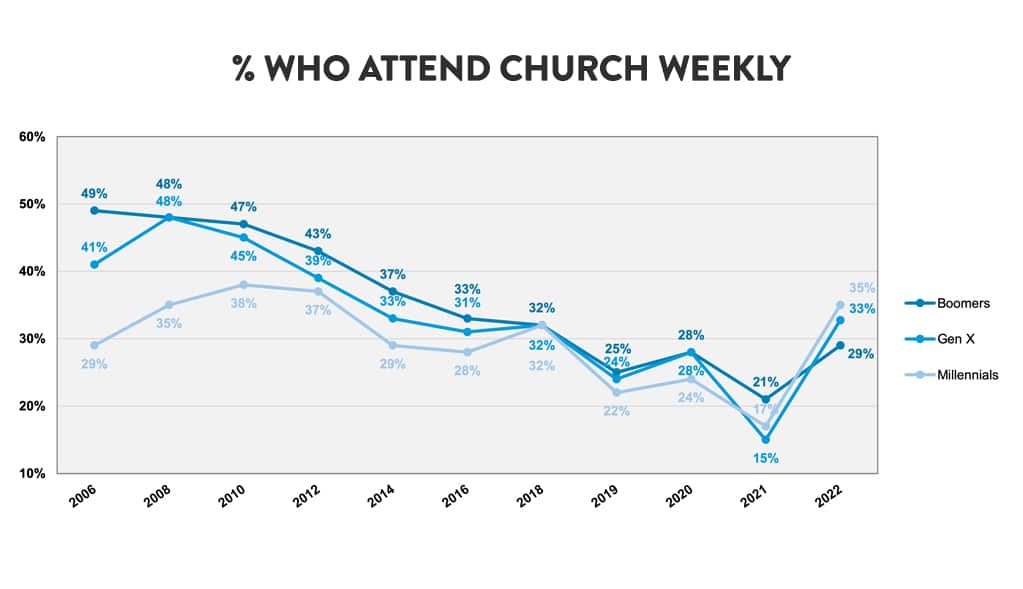
According to a recent Barna study, while Gen Z is the most unchurched generation, it’s also the most open generation to spirituality.
How you handle deconstruction and curiosity will determine whether your church reaches the next generation.
The tendency is to get more narrow or become more embracing.According to recent Barna study, while Gen Z is the most unchurched generation, it’s also the most open generation to spirituality.CLICK TO TWEET
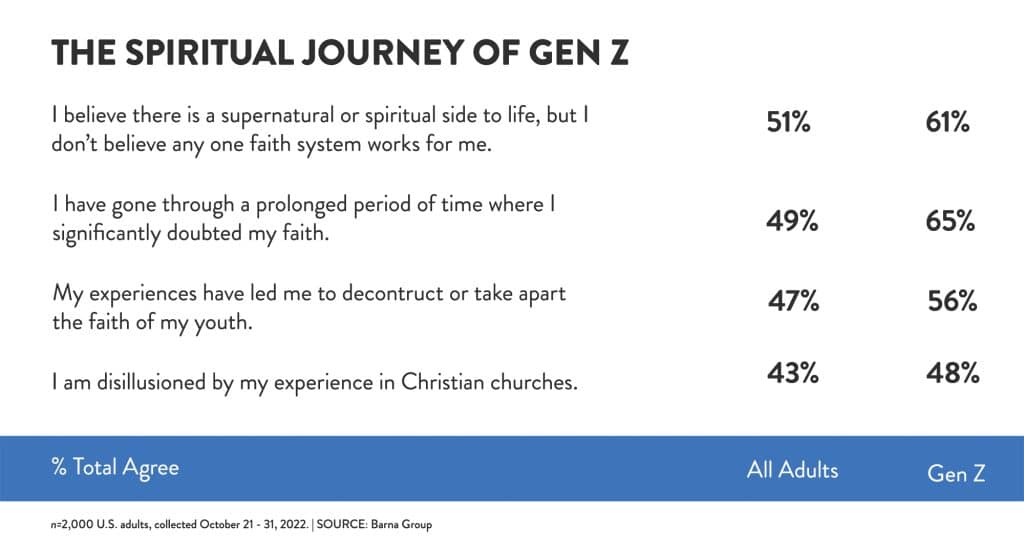
More than any other adults, Gen Z believes there’s a supernatural or spiritual side to life, but doesn’t believe that any one faith system works for them.
Similarly, Gen Z is deconstructing the faith of their youth more than any other generation.
While it’s easy to grow disheartened reading statistics like that, the same study showed that Gen Z is the most spiritually open generation alive today.
59% of Gen Z agrees that they are more open to God today than before the pandemic. Only 34% of Boomers are.
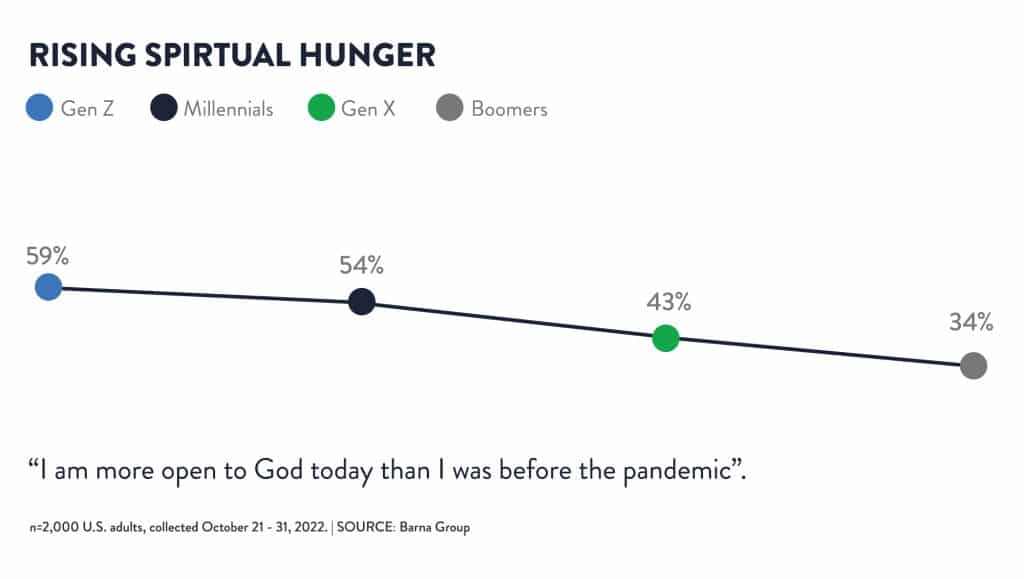
So, what’s the good news?
A spiritually open generation is a reachable generation. Church leaders who are open to change, who are ready for real dialogue, and who are ready to listen to a new generation will find themselves in the best position to reach Gen Z.
And while that doesn’t require a rethinking of the historic orthodoxy of the Christian faith, it does require a rethinking of how we communicate that message and express it.
Wise leaders who are willing to rethink their methods will preserve their church’s mission. A spiritually open generation is a reachable generation. Church leaders who are open to change, who are ready for real dialogue, and who are ready to listen to a new generation will find themselves in the best position to reach Gen Z.CLICK TO TWEET
3. The Line Between Digital and In-Person Will Blur Even More (Take Notes From Taylor Swift)
A fantastic online presence drives demand for in-person experiences because the line between what happens online and in real life continues to get thinner every year.
In last year’s trend post, I made the case that hybrid church will simply become church. As the data in Trend 1 shows, that’s already the case for Gen X and Millennials. It will be even more so the case for Gen Z.
The younger you are, the more easily you slip between the digital and in-person worlds.
Taylor Swift is a prime example of this. In particular, she’s modeling how a strong digital presence can drive an intense in-person demand.
Her Midnights album was released in October 2022. It not only broke streaming records on Spotify (and simultaneously locked up every position on Billboard’s Top 10), it also sold 500,000 physical vinyl albums in a single week.
Read that paragraph again. Using brilliant digital marketing, Taylor Swift sold more vinyl records in a week in 2022 than the Beatles, Elton John, or Queen did back in the day when vinyl was the only format.Using brilliant digital marketing, Taylor Swift sold more vinyl records in a week in 2022 than the Beatles, Elton John, or Queen did back in the day when vinyl was the only format.CLICK TO TWEET
Further demonstrating that online presence fuels in-person behavior emerged when tickets for Taylor Swift’s Eras Tour went on sale. The demand was so high it broke Ticketmaster’s system. Her tour sold 2 million tickets in a single day (more than any artist in history). Finally, Ticketmaster had to shut it down (here’s Ticketmaster’s explanation of what happened).
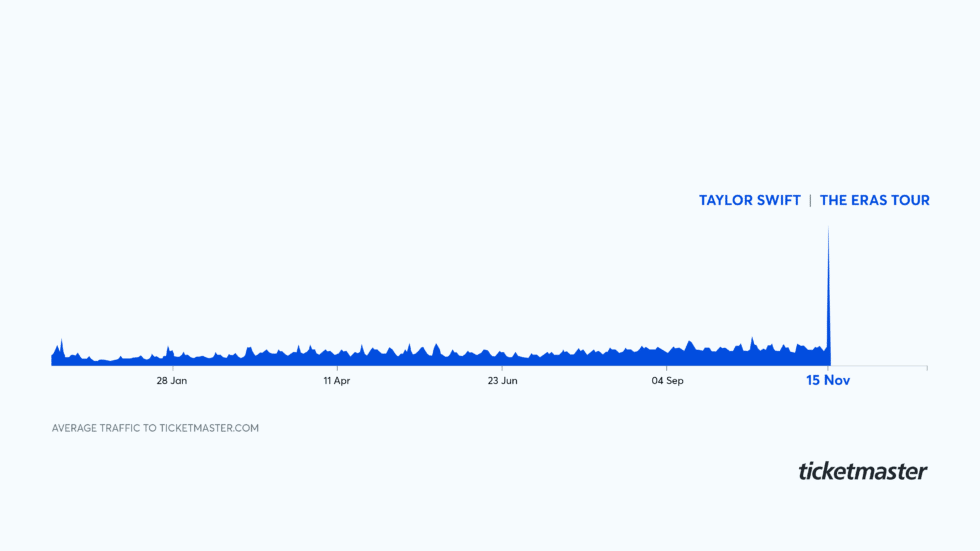
The chart above shows how ridiculously high the demand is for seeing Taylor Swift in person.
So, what’s the point for church leaders?
Simple. A fantastic church online presence drives demand for in-person experiences because the line between what happens online and in real life continues to get thinner every year.
Having a robust online presence isn’t a threat to your in-person experiences. Done right, it fuels them.
In the future church, a robust online experience will lead to a growing demand for in-person experiences. In other words, you’ll get the connection and results you’re hoping for.
Leaders of small church leaders with limited budgets and little to no team aren’t excluded from leveraging their online presence either. As Think Media founder Sean Cannell and I discuss here the options for the small church leader are robust too.A fantastic church online presence drives demand for in-person experiences because the line between what happens online and in real life continues to get thinner every year.CLICK TO TWEET
4. Churches That Embrace Online Ministry Will Start Seeing Results
According to Lifeway Research, before the pandemic, only 27% of churches offered any live-streaming of their services or sermons. Post-pandemic, 92% of churches live-streamed their services.
As the world reopened, a surprising number of churches throttled back their online services, hoping to drive in-person attendance. Not only is that a bad strategy, but it’s also incredibly short-sighted.
First, churches that throttle back their online presence effectively slam the door shut on all the new people they hope to reach. If everyone you want to reach is online, why wouldn’t you try to reach them online?
I outline three reasons you have nothing to fear and everything to gain by investing in your digital presence here. But the real hope is that, finally, some of that investment will start to pay off as you continue it in 2023 and beyond.
First, the people you’re reaching will increasingly want to be connected in person. If you position yourself to facilitate that, everyone wins.
Second, as the line between digital and real-life continues to blur, more and more people seeing spiritual truth will look for it online and investigate further in real life.
The bottom line? In 2023 and beyond, churches that have thoughtfully and strategically experimented with an investment in their online strategies will start seeing results. Not only will attendance grow, but micro-church experiences will multiply, small groups will flourish, and engagement will deepen.n 2023 and beyond, churches that have thoughtfully and strategically experimented with an investment in their online strategies will start seeing results. Not only will attendance grow, but micro-church experiences will multiply, small…CLICK TO TWEET
5. The Purpose of the Weekend Sermon Will Shift From An Attraction to An Anchor
Every generation has exceptional preachers. But with the proliferation of amazing online content, the average preacher will start to realize that the sermon isn’t the draw it used to be. Instead, it’s an anchor.
Go back a generation, and the only way to hear a preacher was to attend a local church. As a result, great preaching drew crowds. And even when the preaching wasn’t that great, it drew people because, well, that was the only place you could really hear sermons (unless you watched TV ministries).
For centuries, sermons were scarce, time-limited events (you had to assemble at 9 a.m. or 11 a.m. to hear one). And as a result, if the preacher was decent, the sermon became a draw that boosted attendance.
Fast forward to today, and sermons from incredible communicators are anywhere and everywhere. They’re also free and available on demand.
The challenge is that many church leaders are behaving like nothing’s changed. Most church communications still go something like:
- Join us for our new series Sunday at 9 and 11.
- Don’t miss last Sunday’s message. Available online, on-demand.
- I can’t wait to share a brand-new message with you.
Except now, people have access to a thousand other sermons. And some of them (let’s be honest) are more compelling than yours.
Please hear me. I am NOT insulting your preaching. I know how hard you work and how sincere you are.
I’m just sharing that things have changed—in my lifetime and yours.
It’s much better to think about the other reasons people gather:
- Community
- Kids and student ministry
- Connection
- An experience that doesn’t always translate online.
And sure, they gather for the message too. It’s just not the drawing card it used to be.
Here’s an honest take (and a bit of a confessional): For a long time, pastors focused on their message because they knew it could draw people in. After all, it’s very addicting to produce a sermon or series that draws a big crowd.
In other words, the sermon was an attraction, and in most growing churches, that’s how it’s still thought of. But with diminishing results (as all the declining attendance data shows).
Here’s what’s shifting: In the future, preaching won’t draw a crowd nearly as much as it will anchor a crowd.
There will be exceptions because every generation has exceptional preachers. But with the proliferation of amazing online content, the average preacher will start to realize that the sermon isn’t the draw it used to be. Instead, it’s an anchor.
That is, with all the competing (often unhelpful or downright bad) information and viewpoints in the world, the preacher’s job will be to help people discern a clear understanding of what’s happening in the world through a Biblical lens.Every generation has exceptional preachers. But with the proliferation of amazing online content, the average preacher will start to realize that the sermon isn’t the draw it used to be. Instead, it’s an anchor.CLICK TO TWEET
6. Content Curation Will Matter as Much as Content Creation
As more pastors are discovering every year, it’s almost impossible to produce top-tier messages week after week that can compete with the best that’s available on the internet. This is not a pressure any previous generation of pastors dealt with, and honestly, it’s an unsustainable pressure.
The push to online and the changing place of the sermon in today’s world can leave pastors feeling an unsustainable pressure to produce a non-stop flow of exceptional content.
As more pastors are discovering every year, it’s almost impossible to produce top-tier messages week after week that can compete with the best that’s available on the internet. This is not a pressure any previous generation of pastors dealt with, and honestly, it’s an unsustainable pressure.
So, what do you do?
Consider curating content, not just creating it.
Content curation is an exploding field.
Defined simply, content curation means gathering information relevant to a particular topic or area of interest and organizing it in a way that’s helpful to the people you serve.
Think of newsletters like The Hustle, Morning Brew, or Five Bullet Friday.
They’re some of the most popular newsletters in the world. Yet they almost exclusively consist of links to articles, videos, and other content that the newsletter writer didn’t create.
Faced with the reality of an open internet and feeling the pressure to ‘perform’ week after week, far too many pastors have succumbed to plagiarism, which I think is a terrible practice for several reasons.
Content curation is different. It specifically acknowledges that this isn’t your idea and instead links to outside sources that people will find helpful (much like the links in this article).
This can show up in two ways for pastors.
First, pastors can curate a variety of voices to preach. In larger churches, this can involve creating a teaching team, a trend that has been well underway for decades but will have to continue.
For smaller churches, curating voices can involve doing pulpit swaps to using free or low-cost videos of other preachers some weekends.
This can help solve the pressure pastors feel to preach powerful, creative messages fifty-two Sundays a year.
There are other content pressures, as well: emails, newsletters, and study guides. This is where curation can play a big role too.
Curation is a great strategy for an email newsletter you send out at your church or articles you post to your website.
Curating links to reputable articles and books can also be a helpful strategy in producing study guides for any sermon series you’re doing.
But what about your voice as a church leader, you might ask?
Your voice still gets heard because people will trust your take on what’s reliable and what’s not on the internet. They’ll also hear your commentary along the way.
If you want an example of how I see content creation creating value for the people you serve, you can subscribe to my new weekly On the Rise curated newsletter here.
In a world drowning in content, people need a trusted voice to help guide them. That voice can be the voice of the local pastor.In a world drowning in content, people need a trusted voice to help guide them. That voice can be the voice of the local pastor.CLICK TO TWEET
7. The Volunteer Crisis Will Move From Acute to Chronic
Wise church leaders will stop making the volunteer ask about what they want FROM volunteers and make it about what they want FOR them instead.
So many church leaders struggled to recruit volunteers as churches re-opened post-COVID. In 2023 and beyond, that challenge will move from an acute crisis to a chronic one.
A few factors have made volunteer recruitment harder than ever:
- First, the return to church meant different people returned to church, and much slower than expected.
- More significantly, as Trend #1 outlined, Boomers are aging out and are the least likely group to return to church. This makes the volunteer backbone of most churches and nonprofit organizations less robust than it used to be. That will only get more challenging as boomers continue to age.
- Plus, the next generations (primarily Millennials and GenZ) attend church less often and have more options on the weekend. And that makes getting them to commit harder.
The best way to counter this is to change how you think and talk about volunteering.
Most church leaders talk about the position, the time commitment, the responsibilities, and the role. That’s not only incredibly de-motivating and uninspiring, but it’s also actually unbiblical.
Many churches today make volunteering more about the organization’s needs than they do about the gifts of the volunteer.
If you take scripture seriously–and you do–then you believe that God actually gives people spiritual gifts. And using those spiritual gifts is key to their development as Christians.
Christians can use those gifts inside and outside the church — they should permeate all of life. But church leaders often approach volunteering at church as though it was about filling slots rather than releasing the spiritual gifts of dozens, hundreds, or thousands of people.
Wise church leaders will stop making the volunteer ask about what they want FROM volunteers and make it about what they want FOR them instead.Wise church leaders will stop making the volunteer ask about what they want FROM volunteers and make it about what they want FOR them instead.CLICK TO TWEET
When people feel seen and appreciated, and when they realize that serving in the church is one of the next expressions of their spiritual gifts, they’ll sign up faster and stay longer.
The volunteer crisis is a vision crisis. And a vision that recaptures the Biblical sense that volunteering is more about the growth of the individual than the needs of the church will help solve the crisis.
It’s the difference between filling church slots and fueling human potential. The volunteer crisis is a vision crisis. And a vision that recaptures the Biblical sense that volunteering is more about the growth of the individual than the needs of the church will help solve the crisis.CLICK TO TWEET
8. Pastoral Burnout will Stabilize As Pastors Embrace Their New Church
Pastors, embracing the congregation you have instead of wishing for the church you used to have or wishing for the church you hope to have will provide much-needed relief. It will also help you make progress.
The last three years have been insanely difficult for pastors and church leaders. There’s no better evidence of this than Barna’s now-famous pastor poll asking pastors if they have seriously considered quitting full-time ministry.
That number peaked at 42% in March of 2022 and declined slightly to 39% in September of 2022. To give you a comparison, the number in 2017 was 11%.
So, why the hopeful prediction that things will stabilize, and pastors will feel less burned out in 2023?
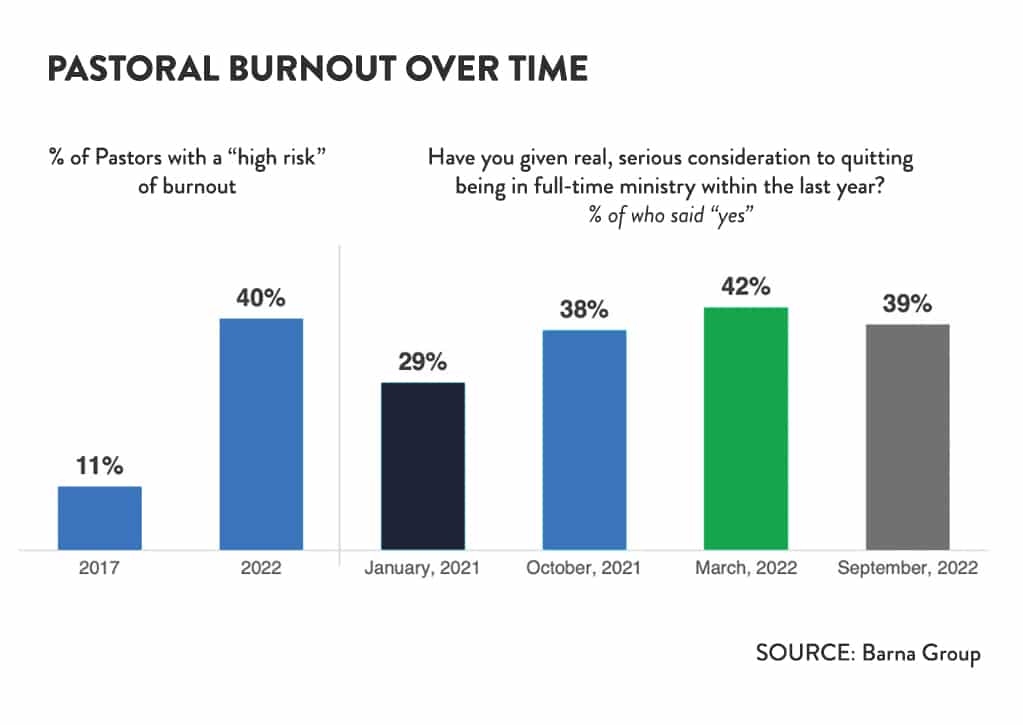
A few things.
First, attendance levels are rebounding. And while external factors ideally shouldn’t drive our mental health, inevitably, they do, and momentum or lack of momentum is a significant issue for church leaders. With attendance slowly increasing, a sense of stability and hope is returning.
Second, with the most chaotic moments of the pandemic in the rearview mirror, pastors can finally tend to their own well-being and the longer-term issues they need to address. Issues like a fresh volunteer strategy, disciple new people, and positioning their church for the future.

Finally, many pastors will finally process their losses and embrace the church they had, not the church they once had, not the church they wish they had, but the church they actually have.
While data isn’t available for this, the pastors I talk to estimate that 30% of their current church is new in the last two years. Even in cases where the church is at pre-COVID attendance levels, it’s not because everyone ‘came back.’ Instead, it’s because some came back, many new people joined, and a new church emerged.
It’s time for pastors to fully embrace the church they have. And in 2023, there will be enough emotional breathing space to do that.
That means baptizing new people, discipling them, and integrating them into the life of the church. It means connecting with new people online. It means connecting long-time attendees with new people in community and through serving. In other words, it feels a lot like normal church.
As pastors step into this and find a sustainable rhythm, the angst should diminish, and some of the joys of day-to-day ministry will return.
It’s impossible to predict when the next disruption or crisis will emerge.
Until then, embracing the congregation you have instead of wishing for the church you used to have or wishing for the church you hope to have will provide much-needed relief. It will also help you make progress.Pastors, embracing the congregation you have instead of wishing for the church you used to have or wishing for the church you hope to have will provide much-needed relief. It will also help you make progress.
CLICK TO TWEET







